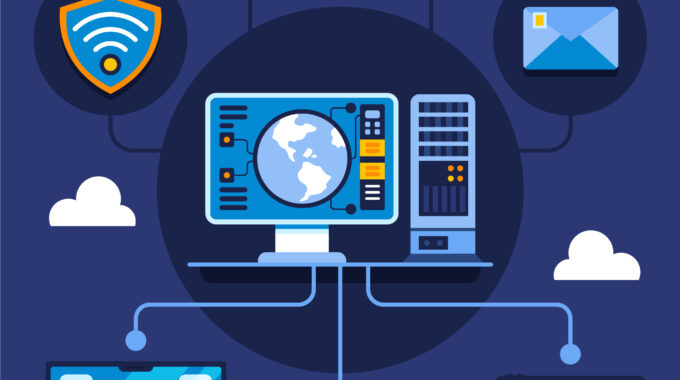Introduction To remain competitive in today's corporate environment, efficiency, speed, and precision are essential. Point-of-sale…

How to Choose the Right POS System for Your Business
Introduction
Selecting the ideal Point of Sale (POS) system for your company is an important choice. The correct point-of-sale (POS) system may improve customer experiences, expedite operations, and give you important insights into your inventory and sales, regardless of the size of your company—be it a little coffee shop, an expanding retail store, or an internet venture. It might be difficult to decide which of the various options available is the greatest fit for your needs. In this article, we’ll explain in plain English how to select the best point-of-sale (POS) system and offer examples to guide you through the process.
1. Understand Your Business Needs
Understanding your unique business demands is the first step in selecting the best point-of-sale system. A POS system needs to have different functions depending on the type of business. For instance, you’ll need a system to track tips, split checks, and take care of table orders if you own a restaurant. Conversely, a retail establishment might place more emphasis on customer loyalty programs and inventory control.
Example: While a boutique clothing company could prioritize a system that interfaces with an e-commerce platform for online sales, a local bakery might need a point of sale (POS) system that manages ingredient inventory and sales data. You can reduce your alternatives by knowing the particular needs of your company.
2. Evaluate the Features You Need
Once you have a clear understanding of your business needs, the next step is to evaluate the features offered by different POS systems. Some common features to consider include:
- Inventory Management: Does the POS system track stock levels and alert you when items are low?
- Sales Reporting: Can the system generate detailed sales reports to help you analyze performance?
- Payment Processing: Does the POS system support multiple payment methods, such as credit cards, mobile payments, and cash?
- Customer Management: Can you store customer data, track purchase history, and implement loyalty programs?
Example: A point-of-sale system that facilitates mobile payments and loyalty schemes, enabling consumers to accrue points for every transaction, could prove advantageous for a coffee shop. Conversely, a clothes business would place more importance on an inventory tracking system that alerts the owner when supplies are running short.
3. Choose Between Cloud-Based and On-Premise Systems
Point of sale systems can be on-site or hosted in the cloud. With cloud-based systems, you can access your data from any location with an internet connection because it is stored on distant servers. On-premise systems provide you more control but also need more upkeep because they store data locally on your own servers.
- Cloud-Based: Ideal for businesses that require flexibility and remote access to data. Updates and backups are managed by the provider.
- On-Premise: Best for businesses with specific security concerns or those that need full control over their data. However, you will need IT support for maintenance.
Example: A high-end jewelry store could pick an on-premise solution for extra security, whereas a food truck might choose an on-premise cloud-based POS system to access sales data while on the road.
4. Consider Ease of Use
A point-of-sale system’s user-friendliness is essential, particularly for companies with several employees who must use the system on a daily basis. An intricate or confusing user interface can cause errors, impede transactions, and annoy staff members.
When evaluating different POS systems, ask the following questions:
- Is the interface user-friendly and intuitive?
- How much training is required to get employees comfortable with the system?
- Is customer support readily available if you run into issues?
Example: A small bookstore with part-time staff that must quickly learn how to use a point of sale system may give priority to one that is simple to master. A tech-savvy electronics business, on the other hand, could feel more at ease with a more intricate system that provides more customizing possibilities.
5. Check for Integration with Other Tools
The majority of firms employ a variety of software tools, including customer relationship management (CRM) systems, e-commerce platforms, and accounting software, to handle various operational elements. To save time and reduce manual data entry, make sure the POS system you choose interacts with the tools you already have.
Example: A flower business that uses QuickBooks for accounting ought to search for a point-of-sale system that works well with the program. Sales and costs will automatically sync thanks to this integration, which will save time and lower the possibility of mistakes.
6. Think About Your Budget
When selecting a point-of-sale system, cost is always an issue. The features, system specifications, and subscription options can all affect the pricing. While some point-of-sale systems require the software and hardware to be purchased ahead, others provide a monthly subscription cost.
Take into account both the initial and continuing expenses for things like maintenance, upgrades, and transaction fees. Make sure the system you select satisfies your business needs and stays inside your budget.
Example: With the knowledge that they may upgrade to a more sophisticated system as their business expands, a fledgling apparel manufacturer may choose for a low-cost, entry-level point-of-sale system with fewer capabilities.
7. Evaluate Customer Support
No matter how good a POS system is, problems will inevitably come up. Customer service is therefore an important consideration. While some systems might only offer assistance during specific hours, others might offer support around-the-clock. Verify whether the company offers phone, email, or chat help, as well as how soon they address problems.
Example: While a boutique that is only open throughout the day might be okay with help that is only available during business hours, a busy restaurant that stays open late into the night might need 24/7 customer service to address any difficulties that arise during peak hours.
8. Test Before You Buy
Utilizing free trials or demos is a smart option before committing to a POS system. This will enable you to verify that the system satisfies your demands by testing it at your workplace. Engage your staff in the process during the trial time to gather their opinions on how the system works in practical settings.
Example: A salon might operate two different point-of-sale (POS) systems concurrently for a week to test them out, get staff feedback, and decide which works best for their operation.
Conclusion Selecting the best point-of-sale (POS) system for your company is a huge decision, but you can make an informed choice by knowing what you need, weighing the features, taking usability into account, looking for integrations, and testing the system. A well-chosen point-of-sale system can enhance customer satisfaction, optimize operational efficiency, and ultimately lead to corporate success. Always take your time, do your homework, and select a system that will work for your business both now and down the road.




